Balzaculator : la Comédie humaine as a binary system for Balzacolytes
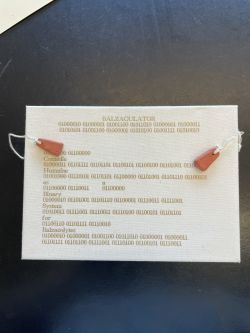
Balzaculator : la Comédie humaine as a binary system for Balzacolytes is an artist book created by American book artist Angela Lorenz in 2013. It feature characters created by French novelist and playwright Honoré de Balzac in his work, La Comédie humaine. Besides the tribulation to Balzac, the artist book also pays homage to Joseph Marie Charles for his role in the institution of the first programmable loom around the time of Balzac's birth through the usage of Jacquard punched cards to showcase the traits of the characters.[1]
Like most artists' books, the Balzaculator is limited in copies with only 33 editions ever created. A copy of this book was acquired by the University of Pennsyvlania's Van Pelt Library through the donations of Ruth and Marvin Sackner Fund and Samuel P. Orlando Fund in 2014
About the Author

Angela Lorenz was born in Boston, Massachusetts in 1955. She attended from Brown University, majoring in Fine Art and Semiotics and graduated in 1987. She currently lives in Bologna, Italy, where she creates most of her artists' books.
Her work focuses on material culture, visual culture and language, expressing them through watercolors, prints, multiples, mosaics and artist’s books. There are over 100 different collections across the world that feature her creations, including exhibitions at he Metropolitan Museum of Art, the National Gallery of Art, The British Library, and the Library of Congress.[2]
In 2019, Lorenz was awarded the prize for Outstanding Contribution to the Art of the Book by Center for Book Arts, New York.[3]
Historical Significance
Joseph Marie Jacquard



Joseph Marie Jacquard was a French weaver and merchant who lived during the Napoleonic era. Jacquard invented the Jacquard machine 1801, to which it simplified how textile patterns were woven. The machine features thousands of punch cards laced together, allowing for greater efficiency in the weaving process while producing patterns with almost unlimited complexity.[4]
The sophisticated design of the Jacquard loom allowed for specific patterns to be produced on fabrics. Due to its long series of interconnected punch cards and its ability to produce patterns, the loom is regarded as the earliest form of computer programming. [5] By having specific orders of holes in a punched card, it allows the machinery to send threads to certain areas on the fabric and create a set pattern. The pattern was used as a data processing service and can keep records (being repeatably used by a worker to create the same pattern) and hence considered to be an early form of computing. [6] Thus, not much effort or skill was needed to produce clothing. As it did not require much menial labor, the job mostly employed women due to the stereotype at the time, where women were considered to be inferior in intellect compared to men.[7]
Honoré de Balzac
Honoré de Balzac was born in 1799, two years before the Jacquard loom was invented. His novel, La Comédie humaine depicts life in France post Napoleon. Due to his unfiltered representation of society, Balzac is regarded as one of the key founders of realism in European literature [8]
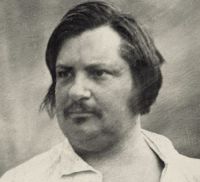
La Comédie humaine is a collection of 90 novels [9] and over 2,000 characters. Some of the same characters could repeat in different novels to give the series better world building and bond between the audience. Various themes are present throughout the series, from money and power to women, society, and sex. [10]
Role of Angela Lorenz
Angela Lorenz picked out 90 characters who have appeared in at least 4 different novels to create her work, Balzaculator. Using Jacquard as an inspiration, she uses punched cards to highlight the novels the characters appears in as well as specific traits a character may have.
Substrate Format
Substrate
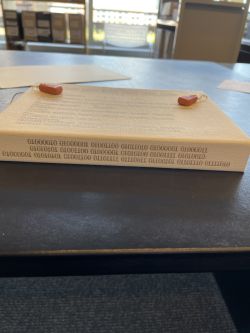
The cover of the book is made from linen canvas. [11] It has a semi-rough texture, kind of like sandpaper, feel. The actual contents of the book are made from thick paper that were ripped in half by hand and act as loose cards. This allows for the individual characters to be placed under the master key punched card for identification. There is also a string that links the front and back covers of the book together to look like loom weights.]
Platform / Format
This book object is more of an artistic creation and does not have the format of a typical printed book. It is a rectangular prism shaped, but all the pages are in the form of loose cards.
Binding / Structure

The artist book is not bounded. All the pages are detachable to act as punched cards. However, there is a string that ties the front cover to the back cover.
While there are no mechanisms for page navigation like page numbers, the book has a key to identify what each colored dot represents and tells a bit about the character’s personality and the novels they appear in La Comédie humaine. The reader can take out any character card from the book and place it under the key to see which novel they appear in. There is also another card that shows the traits of the character (personality, status, gender, etc.) by looking at the colors in the corners of the card.
Paratexts & Illustrations
The Balzaculator has a preface and a dedication to Honore de Balzac. Angela Lorenz also pays homage to Joseph Marie Jacquard for inventing the Jacquard loom
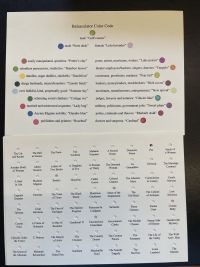
Book Use
Marginalia / Annotations
The book has been written in by the original author in sharpie with proofreading symbols. Per Lorenz’s website [12], she states that “using similar handwriting similar handwriting and correction marks as those invented by Balzac in his own corrected proofs, indicate Balzac’s extreme editing during the printing process.” Lorenz wanted to show the amount of work and thought Balzac had put into his work to create La Comédie humaine and the endless amount of edits that were put in.
Marks
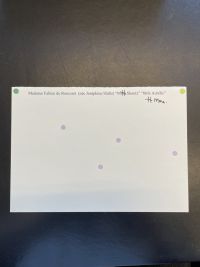
Besides the proofreading symbols written by the original artist, Angela Lorenz, there are no other marks on the book. This was probably due to the fact that this is an artists' book in limited edition, therefore the audience are usually collectors who would not mark the book. Only a limited amount of people could view this book in library or art museum collections, as it is not widely circulated.
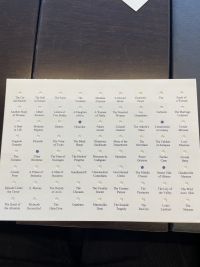
References
- ↑ Angelonium: 76. Balzaculator https://angelonium.com/76-balzaculator/ /
- ↑ Angela Lorenz Artists Books http://www.angelalorenzartistsbooks.com/
- ↑ Maine Media: Angela Lorenz https://www.mainemedia.edu/faculty/list/angela-lorenz/
- ↑ National Museums Scotland, Jacquard loom https://www.nms.ac.uk/explore-our-collections/stories/science-and-technology/jacquard-loom/
- ↑ Ylva Fernaeus, Martin Jonsson, and Jakob Tholander. 2012. Revisiting the jacquard loom: threads of history and current patterns in HCI. In Proceedings of the SIGCHI Conference on Human Factors in Computing Systems (CHI '12). Association for Computing Machinery, New York, NY, USA, 1593–1602. https://doi-org.proxy.library.upenn.edu/10.1145/2207676.2208280
- ↑ Heide, Lars. Punched-Card Systems and the Early Information Explosion, 1880–1945. Johns Hopkins University Press, Baltimore, 2009, doi:10.1353/book.3454.
- ↑ Fast Company: Weaving, Coding, and the Secret history of 'women's work' https://www.fastcompany.com/90425067/weaving-coding-and-the-secret-history-of-womens-work
- ↑ Classe, O. Encyclopedia of Literary Translation Into English: A-L. Taylor & Francis. ISBN 978-1-884964-36-7. Retrieved 26 November 2017 – via Google Books.
- ↑ Britannica: The Human Comedy https://www.britannica.com/topic/The-Human-Comedy-by-Balzac/
- ↑ https://read-dukeupress-edu.proxy.library.upenn.edu/books/book/826/The-Misfit-of-the-FamilyBalzac-and-the-Social
- ↑ Angelonium: 76. Balzaculator https://angelonium.com/76-balzaculator/
- ↑ Angelonium: 76. Balzaculator https://angelonium.com/76-balzaculator/